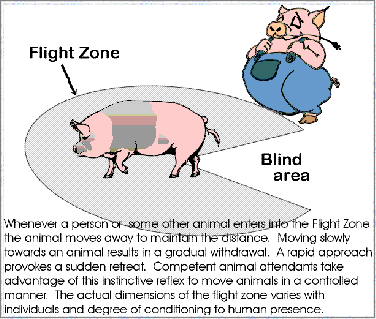

In any new situation or location, all normal, healthy animals are alert and investigative. Every small change or disturbance in their surroundings such as noise, breezes, movement of objects, flashes of light and shadows may frighten the animals. It must be realized that their ability to understand and accept such disturbances is not comparable to that of human beings. Handlers with an understanding of animal psychology can move livestock with minimal excitement and stress. It is a good practice, if possible, for attendants to allow animals to become familiar with them.
Pigs, like most farm animals, have wide-angle vision and relatively
poor depth perception so they are able to perceive and react to visual
stimuli coming from many directions. They are also sensitive to
contrasts caused by color differences, light and shadows, or patterns
in construction materials. An important concept in handling all
livestock is the "Flight Zone" or "Flight Distance".
The "Flight Zone" is the distance from an animal at
which it will choose to move away from an approaching handler.
Whenever a person penetrates the area encompassed by the flight
distance to some critical distance, the animal will make a more
extreme response either by turning back and attempting to run
past him or by breaking and running away from him. Such actions
will disrupt the movement of animals and may increase the incidence
of injury. Good driving procedure involves using the flight distance
such that animals move at a comfortable pace without risk of physical
harm. Attendants should never approach an unsuspecting animal
through its blind area. This usually results in fright and provokes
a panic response. Awareness of the nature of animal vision and
its flight distance are two important features that should be
keep in mind when moving livestock and when designing housing
or handling systems.
depth perception so they are able to perceive and react to visual
stimuli coming from many directions. They are also sensitive to
contrasts caused by color differences, light and shadows, or patterns
in construction materials. An important concept in handling all
livestock is the "Flight Zone" or "Flight Distance".
The "Flight Zone" is the distance from an animal at
which it will choose to move away from an approaching handler.
Whenever a person penetrates the area encompassed by the flight
distance to some critical distance, the animal will make a more
extreme response either by turning back and attempting to run
past him or by breaking and running away from him. Such actions
will disrupt the movement of animals and may increase the incidence
of injury. Good driving procedure involves using the flight distance
such that animals move at a comfortable pace without risk of physical
harm. Attendants should never approach an unsuspecting animal
through its blind area. This usually results in fright and provokes
a panic response. Awareness of the nature of animal vision and
its flight distance are two important features that should be
keep in mind when moving livestock and when designing housing
or handling systems.
Restraint involves complete or partial immobilization of an animal by physical and/or psychological means. It is done to facilitate various management-oriented or medical treatments that must be administered. A little understanding of animal psychology can help handlers to behave in such a way that any restraint is the minimum and least distressing application necessary to conduct the required procedure. Sedatives and anesthetics may be necessary in some instances but are not required usually for routine animal handling or restraint.
Any decision on the type of restraint to be used should be made after an appraisal of the animal's physical condition, temperament, and the procedure that it is to be conducted. An animal in a weakened condition should not be subjected to severe restraint while one that is healthy and vigorous should not be allowed too much freedom to struggle. The choice may be made between general restraint, restraint of a particular portion of the body, or restriction of movement by diversion of the animal's attention.
The pork industry experiences considerable loss in production because pigs are quite susceptible to stress. Lack of knowledge of how to handle pigs can increase distress to the point where it trigger manifestation of the porcine stress syndrome (PSS). Some PSS affected pigs may die suddenly when stressed but many others survive through slaughtering but produce Pale-Soft-Exudative carcasses (PSE).
Despite a pig's hardy appearance, it is not athletic and cannot stand very rough handling, especially in hot weather. If brute force is used, pigs easily become alarmed. Once alarmed, they become obstinate, noisy and even dangerous, particularly when handling older boars or sows with litters. Pigs that have become overexcited with subsequent overexertion, should be allowed to rest, especially confined pigs and pigs that are sensitive to the porcine stress syndrome. If not allowed to rest, they may die from heart failure. However, pigs are not gentle animals and many act belligerently toward attendants and other pigs. They are reluctant to move over strange ground and often attempt to run through any perceived openings, even between the herdperson's legs. Thus, handling and restraining pigs can be an irksome experience. It is important to be patient at all times. Once a competent attendant becomes familiar with the animals, simply talking calmly to them while patting or scratching their backs and heads may be sufficient for many manipulations.
Reasons for handling and restraint
Teeth clipping, tail docking, castration, routine injections, identification, moving to a different pen or farrowing crate, physical examination and treatment, weighing, data and sample collection.
Necessary equipment
Pig handling boards, paddles, trapping crates, snare or snubbing rope, trough, and bucket.
Moving pigs
Restraining pigs
Piglets
Piglets may be held in the hands with one hand under the chest and the other over the back between the shoulders. Never grab piglets by the ears or the tail. They should be caught by the hind legs, picked up gently and held between the hands.
Growing-Finishing Pigs
Older pigs
Casting pigs
Back to Pork Production.